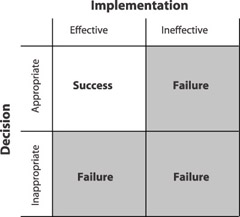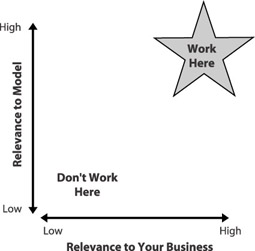WHY PROCESS IMPROVEMENT IS SO DIFFICULT
All organizational change is hard and the change called CMMI-based process improvement is no exception. However, process improvement does have its own characteristics which make it a uniquely difficult organizational change, especially for leadership. Figure 7.5 [46] illustrates one concept about the difficulty of success as it pertains to CMMI-based process improvement.
As Figure 7.5 illustrates, your chances as a leader to successfully implement change in your organization don t start off any better than one in four. Because success requires both appropriate decisions and effective implementation, the odds are against you from the outset. So, we ll get right to the point and give you examples of appropriate and inappropriate decisions and effective and ineffective implementation as they relate to CMMI-based process improvement.

Figure 7.5: Why Success Is So Difficult
Appropriate and Inappropriate Process Improvement Decisions
As an executive, there are really very few decisions you need to make regarding your organization s CMMI-based process improvement, but they are critical decisions that will determine the ultimate results and outcome. The critical decisions you need to make are:
Why?
Why is your organization engaging in model-based process improvement? What business goals do you expect to achieve or what problems do you expect to be resolved by use of CMMI? The section in this chapter, Doing All the Right Things for All the Wrong Reasons gives you some answers you ll want to stay away from. Chapter 4 ” Process Improvement Strategies that Work tells you how to look at your organization from a systems-thinking perspective to understand that CMMI may not be the answer. Finally, Chapter 3 ” Managing the Process Improvement Project ” gives you techniques for determining how CMMI-based process improvement can address business goals and problems.
When?
This is actually the question you re probably going to try to answer first, especially if you ve been given a directive from someone higher up the ladder than you. This is dangerous territory, so be very careful. This will be the first (and maybe last) chance you have to demonstrate your leadership in process improvement. Remember that a whole lot of process capability and organizational maturity is about fact-based estimating and planning. So, if you arbitrarily (i.e., without any factual basis) order your organization to achieve CMMI Level n by a certain date, you have already displaced trust with hypocrisy. In that one act, you will have clearly and overtly demonstrated that you have no intention of demonstrating the behaviors you expect to see in others, specifically making reasonable plans. The minute those words come out of your mouth, you have lost.
Oh, you say, I m just giving them a stretch goal. Have you thought about what a stretch goal really is from someone else s perspective? How about this, a stretch goal is:
-
Management s blatant lack of faith and trust in the ability of their people to accurately estimate and plan achievable work
-
Management s unspoken goal and intention to not have to reward people for achieving goals given that stretch goals, by definition, cannot be achieved
You ve been taught to believe the myth that stretch goals are inspiring , that they get people to achieve more than they normally would. Nonsense. Stretch goals are demoralizing. Even the heroes will not try to meet the impossible stretch goals.
Who?
By who? we mean which parts of your organization really need to be involved in CMMI-based process improvement? What is the scope of the initiative? If you ask people on the help desk to implement all of CMMI, you may get a lot of people spending their time on HotJobs.com because only some small portion of CMMI can be applied to help-desk work. Before giving this answer, think about what CMMI really is ” a model for operational excellence in system engineering and development ” and then and only then decide which parts of your organization should undertake CMMI-based process improvement.
Which Questions Are Not Yours to Answer
One of the characteristics of a leader is knowing which questions and issues in which you should involve yourself and which business to stay out of. If you re an executive and you re getting involved in the detail what and how of process improvement, you haven t learned the role of an executive. You are paying very smart people a lot of money to figure out what to do and how to do it. They have read the books which you have not. They have taken the courses at SEI which you have not. They have attended the conferences which you have not. You have invested a lot of the organization s capital in building their knowledge and skill. If you now don t use that enhanced knowledge and skill, you have wasted the organization s money. Besides, you should have larger matters with which to concern yourself. Find your role and stick with it.
Effective and Ineffective Implementation
Let s get right to the point: If you re an executive, what business do you have in implementation? You are paid for your vision and ideas; you pay others to implement those visions and ideas. You may have come from the ranks of implementers, but now you are expected to lead, which doesn t usually involve sitting down at a keyboard and coding or writing a process description. This book is full of CMMI implementation concepts and techniques you can ask the people involved in your organization s process improvement effort to read.
There is one implementation concept not many people in your organization are likely to think about. Since it is a vision-level idea but affects the approach and implementation of CMMI, you re in the right role to address it. Figure 7.6 illustrates a proven approach regarding where and when to focus process improvement effort.

Figure 7.6: Where to Start CMMI-Based Process Improvement
In Figure 7.6, the cross axes represent two relative scales . The X axis represents the relevance of process improvement work to addressing business goals or resolving business problems. The Y axis represents the relevance of process improvement work to satisfying CMMI process areas or practices. Many organizations start with the focus of their process improvement work high up on the Y axis but on the left end of the X axis. The work has high relevance to CMMI, but low relevance to their business objectives. The reason this happens is usually simply because the organization s leadership doesn t take the time to stop and figure out the relevance between CMMI-based process improvement and their business. Therein lies the executive s or senior manager s job. The most wasteful place to start with process improvement sometimes occurs in organizations in which there is very little comprehension of CMMI and a low understanding of the organization s business needs. In these cases, the organization will inadvertently start process improvement which has little or no relevance to either CMMI or their business. An example of this would be an IT help-desk organization writing procedures for the quality assurance of research papers ” no perceptible model relevance, no perceptible business relevance, yet I ve seen even worse .
[46] This reference and subsequent references are adapted from SEI s course, Managing Technological Change, which adapted materials developed by Implementation Management Associates, Golden, CO.
EAN: 2147483647
Pages: 110